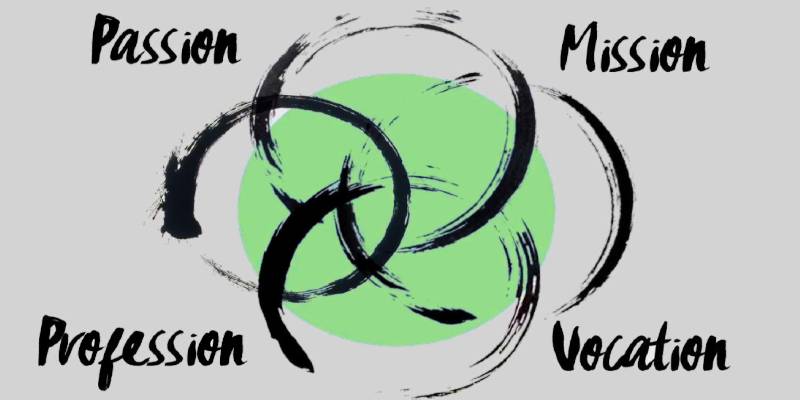What is the Ikigai method and how do you use it to find your calling and purpose? Our guide explains how the method works and how to use it.
What do I want to achieve? What can i do to get there? Perhaps also: What is actually my true calling? The first step on the way to a dream life is to know what it should look like – and it’s not that easy at all. Many do not even know what their true calling is supposed to be. In Japan there is a method for exactly that: Ikigai.
What is the Ikigai method and how can you find your calling with it?
Ikigai comes from Japanese and means, loosely translated: “That which is worth living for”. Anyone who has found their Ikigai should be blessed from now on with joy of life and inner satisfaction. In Japan the belief goes so far that you can live a particularly long time once you have found your ikigai.display
The meaning of life is of course highly individual and depends on the personality, values and living conditions of each individual. Many would also say that calling is not the meaning of life. However, Ikigai says that the mission in life, the true calling, the passion and also the profession are basically the same. Ikigai is the interface between all of these areas.
In other words, if you use the Ikigai method to find what it is worth getting up for in the morning (your calling), you will also find “what is worth living for”.
Find your Ikigai to find your calling
The search for the Ikigai is methodical. So everyone can find their own Ikigai and thus their calling with just a few questions.
That sounds easy, but in practice it is still challenging and requires both patience and the ability to assess yourself.

The Ikigai consists of four areas:
- What you love
- What the world needs
- What you are good at
- What you can be paid for
The intersection of what you love and what the world needs results in your mission in life. The intersection of what the world needs and what you can be paid to make up your calling.
How to find your spirit animal: their meaning and power
Then you can find out your ideal job (the intersection of what you can be paid for and what you are good at) and your great passion (the intersection of what you are good at and what you love).
Where the mission in life, the calling, the ideal job and the great passion overlap, the very personal Ikigai is located. That is why one finds one’s true calling in the search for one’s Ikigai. It is, so to speak, on the way.
Steps to use the Ikigai method
Step # 1: What Do I Love?
In theory, if you want to find your calling, you just need the intersection of what the world needs and what you can be paid for. But we still start with what you love. How so? Because your mission in life, your calling, your job and your passion are all one and the same thing – ideally.
So grab a piece of paper and write down all the things you love. It can be hobbies like reading or cooking, it can be your family, it can be in the sun. There are no restrictions at this point, so write down as much as you can think of.
Sometimes a look back at the past can be a good guide because over time we forget what we really enjoy. What did you like to do as a child? Write it down. How do you forget the time? Write it down. What do you like to talk about Write it down.
Step # 2: What Are You Good At?
Now is the time to write down what you are good at. The rule here is: Don’t be too humble! This is an important step on the way to finding one’s calling. Unfortunately, our self-worth is sometimes so broken that we can no longer do it. So take enough time for it.
Try to remember what you often get compliments for. What did you get the best grades for in the past? Sometimes it also helps to ask a trusted person or two who know you well.
Step # 3: What Does the World Need?
The world or humanity can use a lot and no one can do all of that. But there are things that only you can do. The point of this question is to find everything that you can contribute to the good of the world.
That sounds like a huge responsibility, but it doesn’t have to be anything great at all. Don’t worry now about how you can change the world. Think more in the direction: How can I make the world a little better?
What would be missing if you didn’t do it anymore? Here it can also help to ask about your own values. What is important to you? What makes you sense What makes you feel good
Step # 4: What Can You Be Paid For?
Now follows one of the most important questions in finding a calling: What can you be paid for? The most banal answer to that is your current job. After all, that’s what you’re getting paid for. This is a start, but there are more options!
What jobs did you do in the past? What skills do you have that others already use to make money? Do you have a hobby that has potential for income?
Step # 5: Put the answers together
Take a large sheet of paper and draw four overlapping circles of equal size on it. Now fill in all the answers that you wrote down earlier. This is where the hard part comes: filter out the intersections and enter them into your drawing as well.
You will be surprised what such a visualization of your skills and desires can trigger. You may even have the enlightenment you want about what your true calling is.
Graphic showing the Ikigai principle. Ikigai is the intersection of your passion, your calling, what you are good at and what people need.
This is how you find your Ikigai
To see your own calling only on paper does not change anything in your own life. So if you long for more fulfillment and personal development, you have to act.
Think in small steps. You don’t have to turn your life 180 degrees immediately. Even small steps can bring you closer to your goal. For example, you could first do an internship or do voluntary work if you want to change your career.




